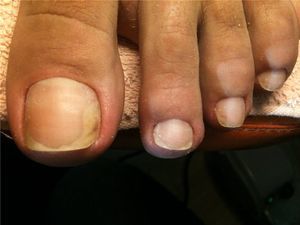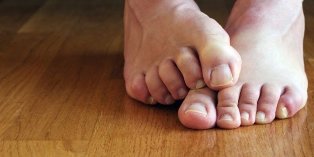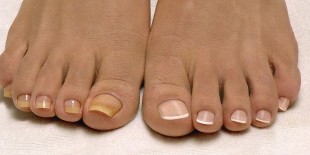Among the people frequent a variety of disorders, which does not threaten life, but it brings serious discomfort. Onychomycosis is a representative fungal diseases. He hits the nail plates, completely destroying them. Moist and warm environment is perfect for his breeding. The symptoms of nail fungus on your feet wear often hidden, and eventually the disease is detected already in the running form.

Basic types of fungal infections
Nails caught off guard by the different types of mycosis. The most commonly encountered dermatophytes. Trichophyton red affects the skin on the hands and feet. Its main manifestations — spots of yellow or white color on the nail plate. Gradually the size of the outbreak grows, changing the color of the entire nail, and he begins to move from the bed. In severe cases, it leads to fungus, which affects the skin.
Trichophyton Mentagrophytes begins interdigital area, after which it above. Is manifested by a yellow or white point, which is transformed in the subungual hyperkeratosis. Usually the disease affects only the large toes or small toes. Its causative agent active just multiplies in the warmer months.
Much less frequently occurs Trichophyton purple. It is more extended to the Far East and in Central Asia. It amazes hairy part of the head and is better known as shingles. If left untreated, the nails will appear dark hillocks.
Fungus under the toenails occurs and due to the infestation of the yeast fungus. Activators — candida white, and candida parapsilosis. The disease usually appears on the background of already existing onichamykóza.
The main symptoms of the lesions yeast fungi:
- white spots on the nails, which over time become inactive;
- inflammation of the cuticle;
- purulent discharge.
All of these symptoms bring severe pain. Frequently occurring yeast-like fungi become a professional disease that develops in people who have sustained contact with water. In the absence of timely treatment, the nail plate dwindling, and depart from the bed.
Even less often encountered form of mold. The first is similar to the manifestation of candida and is usually formed after injury to the big toes, and the other spots toenails black dots.

Classification of fungal lesions
The symptoms of nail fungus are varied. Are dependent on the form of the disease and its severity. Some doctors share mycosis localization and penetration depth:
- In the distal form of prejudice to the surface of the free edge, the color of the plate changed to brown or yellow. Over time, the size of the affected area is taken, and the structure of the nail is changing into a rough, uneven.
- The side form is manifested similarly, only the affected side of the nail.
- In the proximal form the infection begins with the cuticles. From the skin roller the spread of white spot, which is becoming more and more. The surface becomes cloudy and loses its gloss, in severe cases, begins to crumble.
Some doctors prefer to classify the disease, focusing on the degree of thickening of the nail. When working trophic form is still not changed size, but are seen foci of the disease. In hypertrophic happening overgrowth of skin, which leads to a thickening of the nail and discomfort when walking. Atrophic form leads to a complete rejection of the nail plate.
The complexity of the treatment of fungal lesions of the nails on the foot lies in the fact that in most cases the disease is detected at the running stage, when already experiencing atrophy. The first symptoms of infestation — dots or stripes on the nail plate. They do not bring any discomfort, because of what the people and do not pay attention to fix the problem in a timely manner.
The characteristic symptoms of
Find out how it looks like nail fungus on the feet, is simple enough: on the plate will appear colored spots, it may deform, peel off and depart from the bed. When disease progression of the lateral rollers blush and peel. Some forms are accompanied by a rash in the interdigital area.
One more characteristic symptom is a burning sensation and itching. The skin on the side pillows thickens and begins to peel off, after which, and the irritation appears. Combing only strengthens it a very unpleasant feeling.
The first sign of nail fungus on the feet — it's not just changing the color of the plate, but also the loss of his brilliance. It becomes cloudy, with the progression of the disease becomes gray. In an effort to cut actively crumbles and breaks, with time to make everything more complicated. Often the process is accompanied by an unpleasant odor. In more advanced cases, the whole will be a nail plate develop a yellowish thickened so much that it is no longer possible to cut.
Feelings of pain arise only rarely. They can appear in the result, that the plate thickens and begins to grind about the shoes — it also brings discomfort. In some cases the pressure on the affected areas raises the ingrown nail on the side rollers.
Due to the spread of the dispute in the soft tissues of the disturbed nerve endings. Can provoke paroxysmal pain, which appears even in moments of tranquility. In severe forms of the mold affected area between the toes. Rash in the form of small blisters covered the skin, and when they burst, in their place appear ulcers, the provision of serious discomfort while walking.

Methods of treatment
To refine the diagnosis necessarily carry out the laboratory diagnosis. Only she gives us the possibility to exactly determine the causative agent of the disease and allows you to pick up effective treatment. The complex therapy includes medicine for indoor and outdoor use. Ointments are applied to clean and dry the area.
The choice depends on the pathogen of the disease. Duration of the course is set up individually, but usually miss two months. Treatment necessarily continue even after the disappearance of symptoms.
Be sure to use the drugs for oral ingestion. They are designed to destroy mold spores. In the course of treatment the patient should be checked regularly by a doctor and pass the exams. This will allow to determine the effectiveness of the treatment.
In rare cases, use a surgical removal of the affected part of the nail. Such a way to avoid infection, and this means that the new board will be smitten with a mycosis. Hardware pedicure — more sparing technique that allows you to painlessly remove the Horny layer. Cleaning carried out with a frequency of once every two weeks until complete removal of the affected areas.





























